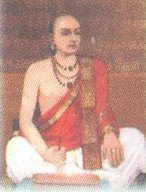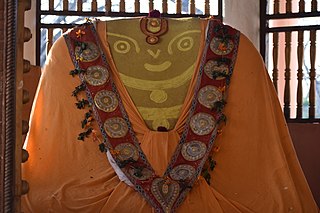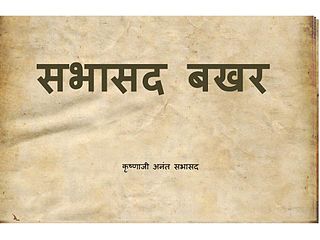Related Research Articles

Nannayya Bhattaraka was a Telugu poet and the author of Andhra Mahabharatam, a Telugu retelling of the Sanskrit-language Mahabharata. Nannaya is generally considered the first poet of Telugu language. He was patronized by Rajaraja Narendra of Rajamahendravaram. Rajaraja Narendra was an admirer of Mahabharata and wanted the message of the Sanskrit epic to reach the Telugu masses in their own language and idiom. He commissioned Nannaya, a scholar well versed in Vedas, Puranas, and Itihasas for the task. Nannaya began his work in c. 1025 CE and wrote Adi Parvam, Sabaparvam, and a part of Aranyaparvam.

The Sena dynasty was a Hindu dynasty during the early medieval period on the Indian subcontinent, that ruled from Bengal through the 11th and 12th centuries. The empire at its peak covered much of the north-eastern region of the Indian subcontinent. The rulers of the Sena Dynasty traced their origin to the south Indian region of Karnataka.
Daulat Qazi was a medieval Bengali poet. He was born into the Qazi family of the village of Sultanpur in Raozan Upazila, Chittagong. Not getting any recognition at home, he left for Arakan, where he seems to have been received warmly.
Dravida Brahmins, or simply Dravidulu, is a sub-caste of the Telugu Brahmins of Andhra Pradesh in South India, who migrated from Tamil-speaking regions. They are further divided into sub-sects based on the places where they have settled such as Aaraama Dravidulu, Pudur Dravidulu, Konaseema Dravidulu, Peruru Dravidulu, Tummagunta Dravidulu and Dimili Dravidulu.

Dr. K. Ayyappa Paniker, sometimes spelt "Ayyappa Panicker", was a Malayalam poet, literary critic, and an academic and a scholar in modern and post-modern literary theories as well as ancient Indian aesthetics and literary traditions. He was one of the pioneers of modernism in Malayalam poetry, where his seminal works like Kurukshethram (1960), is considered a turning point in Malayalam poetry. Many of Ayyappa Paniker's poems and his several essays were an important influence on later generations of Malayalam writers.
Rudrabhatta was an influential 12th-century Kannada poet in the court of the Hoysala Empire King Veera Ballala II(r.1173–1220 CE). According to Kannada language expert Narasimhacharya, the poet was also patronized by a minister of the King. The literary critic Mukherjee feels that after a century of literary revolution caused by the Veerashaiva poets, a benevolent atmosphere created by the king may have encouraged this Vaishnava writer and poet.
Jyotirishwar Thakur or Kaviśekharācārya Jyotirīśvara Ṭhākura (1260–1340) was a Maithili poet, playwright, musician and an early Maithili and Sanskrit writer, known for the Varṇa Ratnākara, his encyclopedic work in Maithili.
Brajabuli is an artificial literary language popularized by the Maithili poet Vidyapati. His Brajabuli lyrics about the love which were turned out to be for Radha Krishna later on these are considered his best work. Other poets emulated his writing, and the language became established in the 16th century. Among the medieval Bengali poets who wrote in Brajabuli are Narottama Dasa, Balarama Das, Jnanadas, and Gobindadas Kabiraj.
Chakradhara, also known as Sarvadnya Shri Chakradhar Swami or Kunwar Haripaladeva was an Indian saint and philosopher, who is considered as an avatara of Krishna by his disciples and one of the most important exponents of the Dvaita tradition within Hinduism. He is the founder of Mahanubhava Sampradaya of Krishnaism. Shri Chakradhar Swami advocated worship of Lord Krishna and preached a distinct philosophy based on Bhakti. He did not recognize caste distinctions, and like Buddha had only two others viz the householder and recluses. Some sources claim that Chakrapani Prabhu and Govinda Prabhu as the originators of Mahanubhava doctrine and Chakradhara as the first apostle who systematized Mahanubhava as a school of Bhakti philosophy. Chakradhara's birth anniversary is observed on the Tithi of Bhadrapada Shukla Dwitiya.
Thiri Thudhamma whose personal name was Min Hari (မင်းဟရီ), also known as Salim Shah II was a king of the Mrauk-U Dynasty of Arakan.

Jasobanta Dasa was an Odia poet, litterateur and mystic. He was one of the five great poets in Odia literature, the Panchasakha during the Bhakti age of literature. He is known for his work Prema Bhakti Brahma Gita.
Khyat is a form of bardic historical prose that was prevalent in the western Indian states of Rajasthan and Gujarat. It is a collection of events or continuous history. Khyats generally contained histories of a ruling dynasty or a person. In the former states that now constitute Rajasthan, Khyatas were written by the Charans under the patronage of rulers who wished to perpetuate their exploits. These accounts contained histories of battles, sacrifices, valour, and chivalry, values that came to be associated with Rajputs. Khyatas are often known by the name of their authors; e.g., Bankidās-ri-Khyāt. Nainsi-ri-Khyat written by Nainsi is considered to be the most prominent of khyats.
Dom Antonio de Rozario was a Christian missionary from Bengal. He was the first writer of Bangla prose.

Shri-Shiva-Prabhuche-Charitra, better known as Sabhasad Bakhar, is a Marathi language biography of Shivaji, the founder of the Maratha Empire. It was written by Krishnaji Anant Sabhasad at Jinji, at the court of Shivaji's son Rajaram in 1697.

King Loiyumba, also known as Meidingu Loiyumpa, was a Meitei monarch and a ruler of Kangleipak kingdom. He was the first king to order a written constitution in the 11-12th century CE which is known as the Loiyumpa Silyel .

Chewdara or Chivdora, is a village in the Rathsun block of the Beerwah tehsil in Budgam district of Jammu and Kashmir, India. It is located 21 km (13 mi) towards west of the Budgam district headquarters, 3 km (1.9 mi) from Beerwah and 23 km (14 mi) from the winter capital Srinagar. Chewdara has two panchayats, Chewdara-A and Chewdara-B.
Shakti Ballav Aryal was a Nepalese writer, translator, and a Hindu priest.

Meitei mythology or Manipuri mythology is a collection of myths, belonging to the religious and cultural traditions of the Meitei people, the predominant ethnic group of Manipur. It is associated with traditional Meitei religion (Sanamahism). Meitei myths are a part of Meitei culture and explain various natural phenomena, how the human civilization developed, and the reasons of many things happening. Most of the Meitei legends are found in the Meitei language texts.

Leithak Leikharol, also spelt as the Leithak Leikhalol, is an ancient literary narrative work (puya), about the creation of the universe, genealogy of kings, moral teachings and mythology. It mentions some goddesses including Leimarel Sidabi, Nongthang Leima and Panthoibi. Goddess Leimarel Sidabi is said to be the omniscient. It states that goddess Panthoibi slays a demon.

The Phouoibi Waron or the Phouoibi Warol is a Medieval Indian Meitei text (Puya) written in a period between 13th and 14th century AD. It deals with the life story of the lovers of Phouoibi, the goddess of agricultural crops and harvest in Meitei mythology and religion (Sanamahism).
References
- ↑ MAJUMDAR, R. C. (1971). HISTORY OF ANCIENT BENGAL. G. BHARADWAJ , CALCUTTA. p. 220.
- ↑ Paniker, K. Ayyappa (1997). Medieval Indian Literature: Surveys and selections. Sahitya Akademi. p. 22. ISBN 978-81-260-0365-5.
- ↑ Paniker, K. Ayyappa (1997). Medieval Indian Literature: Surveys and selections. Sahitya Akademi. p. 22. ISBN 978-81-260-0365-5.
- ↑ Das, Sitanshu (1999). Indian Nationalism: Study in Evolution. Har-Anand Publications. p. 81. ISBN 9788124106204.
- ↑ Ronald. B. Inden (January 1976). Marriage and Rank in Bengali Culture : A History of Caste and Clan in Middle Period Bengal. University of California Press. p. 60. ISBN 9780520025691.
- ↑ Under the Bo Tree . University of California Press. 1967. pp. 371–. ISBN 9780520020542 . Retrieved 2 August 2011.
- ↑ Dinnell, Darry (2021-04-01). "Review of The Other Rāma: Matricide and Genocide in the Mythology of Paraśurāma". Journal of Dharma Studies. 4 (1): 155–157. doi:10.1007/s42240-021-00095-1. ISSN 2522-0934. S2CID 233676041.
- ↑ Isaka, Riho (2002-04-01). "Language and dominance: The debates over the Gujarati language in the late nineteenth century". South Asia: Journal of South Asian Studies. 25 (1): 1–19. doi:10.1080/00856400208723463. ISSN 0085-6401. S2CID 144468128.
- ↑ Shah, A.M. (210). The Structure of Indian Society: then and now. Routledge. p. 175.